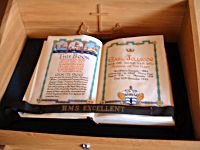Location
Next to the Jellicoe WW1 Memorial, against the northern wall of the nave (opposite the altar) in St Barbara's Church
Description
The Book of Remembrance is held in a glass topped wooden box.

THIS BOOK
WAS PLACED HERE
ON 31ST MAY 1937
IN REMEMBRANCE
OF LORD JELLICOE
& AS AN ADDITION
TO THIS MEMORIAL
Upon its pages
are recorded the names of those gunnery
Officers, Commissioned Gunners, Gunners
Gunners' Mates, Ordnance Artificers and
Chief Armourers who have laid down their
lives while serving in the Royal Navy since
the end of the Great War together with the
names of those especially connected with
H.M.S. Excellent whom it is desired to
remember here.
Inscription (Title Page - Right)
EARL JELLICOE
G.C.M. O.M. G.C.V.O. L.L.D. D.C.L.
ADMIRAL OF THE FLEET
Qualified in Gunnery 1884
Commander-in-Chief Grand Fleet
August 1914 - November 1916
Died 20th November 1935
Further Information
John Rushworth Jellicoe was born at Southampton on 5 December 1859, the second of four sons of John Henry Jellicoe (1825–1914), a captain in the Royal Mail Steam Packet Company, and his wife, Lucy Henrietta (d. 17 Oct 1916), daughter of Dr John Rushworth Keele, also of Southampton.
Jellicoe was nominated for the Royal Navy in 1872 when he joined the cadet training ship HMS Britannia, moored in the River Dart. He was then only 4 feet 6 inches tall, and would remain of slight stature throughout his life. He gained first-class certificates in all subjects and was immediately promoted midshipman. In 1874 he joined the wooden steam frigate Newcastle which roamed the globe for the next two and a half years. he returned to Britain in 1877 and for the next seven years devoted himself to his naval education and absorbing all the experiences that the navy could offer him. In May 1884 he qualified as a gunnery lieutenant at HMS Excellent, and was immediately appointed to the staff of the gunnery school by her captain, John Arbuthnot Fisher who was destined to rise to Director of Naval Ordnance and take Jellicoe along with him to Whitehall as his assistant.
Promoted commander in June 1891 Jellicoe left the Admiralty to become executive officer of the new battleship Sans Pareil (Captain Arthur Wilson), joining the Mediterranean Fleet and the following year moved to the flagship Victoria, at the request of the Commander-in-Chief, Admiral Sir George Tryon. On 22 June 1893 the Victoria sank off Tripoli after being rammed by Camperdown, an accident caused by the failure of any subordinate officer to query an order given by Tryon which was impossible to execute. At the time Jellicoe, suffering from Malta fever, was confined to bed. Going on deck after the collision he was fortunate not to share the fate of 358 of his shipmates who are named on a memorial in Victoria Park.
In December 1896 Jellicoe returned to England, was promoted captain on 1 January 1897 and later that year returned to sea as flag captain to Admiral Sir Edward Seymour, commander-in-chief on the China station, in Centurion. This was the time of the Boxer Riots and although Seymour had no troops, he assembled a force from the various national squadrons with the aim of getting through to Peking. The expedition was not a success and in the retreat Jellicoe was shot in the chest.
[There is a memorial to the men who lost their lives on the expedition in Victoria Park]
Returning to the Admiralty in March 1902 as assistant to the third sea lord and controller, Admiral Sir William May, Jellicoe spent much of his time visiting shipyards. In July 1902 he married Sir Charles Cayzer's second daughter, Florence Gwendoline.
After a year commanding the cruiser Drake, where he adopted the gunnery reforms developed by Captain Percy Scott, Jellicoe was recalled to the Admiralty in November 1904 as director of naval ordnance, by Fisher, newly installed as First Sea Lord. In February 1907 he was promoted rear-admiral, and in August he was appointed second in command of the Atlantic Fleet with his flag in the pre-dreadnought battleship Albermarle. In October he was knighted and invested as KCVO. Jellicoe spent most of the remaining years that led up to the First World War at Whitehall engaged in the political battle to order the Dreadnoughts that he knew were essential to the Navy's ability to fight a war at sea. He did however spend some time as acting Vice-Admiral commanding the Atlantic fleet but colleagues noted that although he could see flaws in everything and everyone, Jellicoe lacked the ruthlessness to sack incompetents, made too many allowances for old friends, and did too much of everyone else's work.
in July 1914 Jellicoe found himself appointed second in command of the Grand Fleet, which contained all the modern battleships, and set off for Scapa Flow to raise his flag aboard the Iron Duke. For two years he worked at improving the technical proficiency of the fleet until at the end of May 1916 he was ready to face the German fleet. Unfortunately the communications system failed to offer him a complete picture of what the Germans were preparing.
